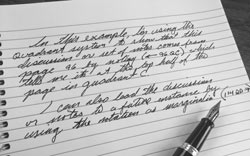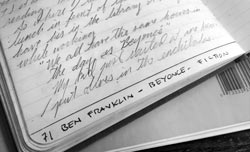Developing your own BuJo style is part of the reward for using the Bullet Journal. Here are some Analog Attorney favorites.

Table of contents
Since Ryder Carroll put his original Bullet Journal video on YouTube, his technique for using a running, minimal, bullet-point-based paper notebook has taken over the internet. There are countless dedicated groups on Facebook, Instagram and Pinterest. Vloggers by the hundreds have broadcast their experiences using the Bullet Journal (BuJo for short). Leuchtturm offers a preformatted notebook designed by Ryder. BuJo is huge.
But people were gushing over their journals long before Ryder launched his website in 2013. In the late 1990s, Moleskine resurrected the iconic French journal favored by Hemingway, Matisse and Picasso. By the early aughts, the company was shipping 30,000 a week. There are millions of images of drawings, doodles and notes posted online by Moleskine devotees.
The Bullet Journal arrived at a critical moment in the developing trend of minimalism. From tiny houses to tidy homes, people began learning the value of decluttering, downsizing and detaching from their digital world. During the pandemic, journaling became a way to cope for many, and Bullet Journal — whether you use a prescribed method, something you’ve customized or even (gasp) combined with an app — has continued to grow in popularity.
Related: Read one lawyer’s method in “Pen on Paper Works! The Bullet Journal” by Mary Lokensgard
Here are a handful of non-Bujo hacks you can use with your Bullet Journal.
1. The Japanese Edge Mark Index
This brilliantly simple index for paper notebooks is similar to the scalloped pages one finds in a good dictionary. Create a listing on the back page every time you begin a new subject in your journal. Color the edge of the page exactly adjacent to that subject heading. Then color the edge of any pages that contain the subject so they align with the mark you made on the back page. Now you can see along the edge of your journal everywhere you’ve written about this subject. Further instructions can be found on HighFiveHQ.

2. Add the GTD System to Your Bullet Journal
David Allen’s “Get Things Done” method for time management was designed to be platform neutral, so it can be implemented in Evernote or a pile of index cards. The GTD system takes tasks and ideas through five steps of focus: capture, clarify, organize, reflect and engage. Capturing your ideas, tasks and project notes is a critical function of GTD since you can’t follow through on what you can’t recall. Whether you use an app or your notebook, the threshold for usefulness must be low enough so you are able to add a note instantly.
3. Paper Hyperlinks and the Quadrant System
An index is a great idea for finding a page, but the quadrant system tells you where the indexed information appears on a page. If you fill several pages at a time with your thoughts and notes, this method is borderline magical. There are two components to the system, as explained by Leslie S. Russel (a link to the original article is, unfortunately, unavailable).

First, you mentally divide page spreads in your notebook into four quadrants labeled A, B, C and D.
If you return to an idea on, say, page 134 of your notebook which you originally began on page 96, you add an inline markup to thread them together. It’s an analog hyperlink. An arrow pointing left means “from” followed by the page number, 96. An arrow pointing forward following a page number indicates where this idea thread picks up later in your journal.
Add the quadrant number and you have a very precise method for linking idea threads across many pages.

4. Use Icons to Jog Your Memory
There seem to be two kinds of Bullet Journalers: minimalists and doodlers. Minimalist systems use sleek, elegantly structured pages using the least amount of ink to organize the page into usable sections. Doodlers turn their journals into continual works of art with myriad colors, illustrations and wildly flourished page headers. There is, fortunately, a happy and useful medium. Thoughtful web designers direct users around their pages using crisp icons because an icon expresses intent instantly. This works on paper just as well. Add just a couple of small pictographs into your page designs and finding information later is a breeze. Do you take notes during calls? Drop a small picture of a phone in the margin. It will jump out at you next time you’re thumbing through your notes looking for that one thing that one guy said in that one call.

5. My Own BuJo Hack: Running Footnotes
My notebooks are dense with text. I’ve cherry-picked from various productivity methods, combining elements of GTD, BuJo and others in a system that works for me. Numbering pages is one of the most important notebook hacks. I’ve started adding a running footer on my pages. Besides the page number, I add a single word that will trigger my memory when I’m looking for a notation. It might be just the theme of the page, “motorcycles,” or it might be more specific, “Franklin quote.” Sometimes I add the paper links or a quadrant note, so it might read “<–– 45-Franklin quote-Q4”.

There are multitudes of hacks out there. You might like using rubber stamps, MUJI tape or Post-it tabs. The system is remarkably adaptable and plays well with others. Developing your own BuJo style is part of the reward for using the Bullet Journal.
For more Analog Attorney tips on journaling, read:
Photo by Andres Molina on Unsplash
Subscribe to Attorney at Work

Sign up for Attorney at Work’s daily practice tips newsletter here and subscribe to our podcast, Attorney at Work Today.

















